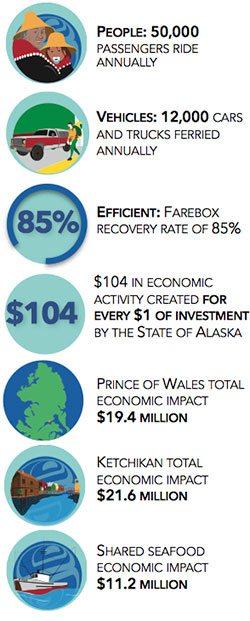
Inter-Island Ferry Generates More Than $50 Million in Economic Activity Annually
February 19, 2016
“We have always known that the IFA plays a significant socio-economic role in southern Southeast Alaska,” explains Dennis Watson, General Manager of the Inter-Island Ferry Authority. “However, it has not always been easy to convey this message. This publication concisely describes and calculates the economic and social impacts of daily ferry service between Prince of Wales Island and Ketchikan.” Some other highlights of the study include the following:
Document summary: The Inter-Island Ferry Authority (IFA) provides daily service on a three-hour, 36-mile route between Prince of Wales Island and Ketchikan. It ferries more than 50,000 passengers and 12,000 vehicles between Hollis and Ketchikan annually. The system is more than a form of transportation - it is an economic engine for southern Southeast Alaska, generating jobs, commerce, and tourism while also increasing community well-being. In 2015, the IFA brought 3,000 tourists to Prince of Wales Island, where they spent more than $10 million on hotels, fishing expeditions, and dining - generating hundreds of summer jobs across the island. It provides a means for the seafood industry to move millions of pounds of high-quality, high- value fresh and live seafood to market, creating hundreds more jobs. It provides access to health care for a thousand island residents who use Ketchikan’s medical services without the cost, inconvenience, or weather-related delays of flying. It shuttles workers to their jobs. It reinforces Ketchikan’s status as the regional economic hub, as Prince of Wales residents spent more than $14 million there in 2015 on groceries, goods, services, and medical care. The Inter-Island Ferry allows for cultural and social commerce as well. Students, tribal members, and other residents use the system to participate in basketball games, totem pole raisings, trainings, college fairs, celebrations, and funerals. There were 3,100 student trips last year. This allowed students from 13 different Alaska school districts the opportunity to challenge themselves and interact with their peers. It connects residents to family, friends, and recreation. The ferry is a critical piece of a more extensive transportation network. It provides transportation security on days when the skies are rough, and access to transportation to those who cannot afford alternative means. Nearly a quarter of the ridership last year were senior citizens and young children, who have saved a combined $17 million over the cost of flying since the system began in 2002. Its reliable arrivals and departures have enabled organizations to build their business models around this daily transportation connection. The result of the IFA’s efficient operations is farebox revenue that covers a full 85% of the ferry’s operational costs, a significant rate in the world of public transportation. The word businesses and residents most frequently use to describe the ferry service is “invaluable.” While there are many intrinsic values of the system that cannot be measured, an analysis of the ferry’s economic impact in the seafood, healthcare, visitor, transportation, and retail sectors shows an impressive $52.2 million combined impact in Ketchikan and Prince of Wales in 2015.
Edited by Mary Kauffman, SitNews
Source of News:
|
|||
